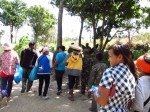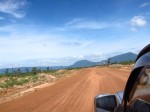The Angkor kingdom ruled what is now Cambodia, southern Vietnam and parts of Thailand from the 9th to the 14th centuries. The capital is believed to have spread over 1000 square kilometres around what is now Siem Reap. It had elaborate systems of infrastructure, particularly involving the use of water, and the city, which was more of a general concentration of people than an industrial city, may have housed up to a million people.
The temples of Angkor are spread over a large area. Most visitors to Siem Reap visit a few of the most famous ones – mainly Angkor Wat, Bayon and the Angkor Thom area, and Ta Prohm – which are very close to each other and a few kilometres north of Siem Reap. Some venture further afield, to the small but exquisite Banteay Srei (Citadel of the Women) and, more recently, to Beng Mealea.
Preah Vihear (Mountain of the Sacred Monastery) is a long way from Siem Reap, close to 200 kilometres, the last part of which is on a very rough dirt road. It is a full day trip.
It is set in the most spectacular setting of the Angkor temples, on the peak at the edge of Pey Tedi, a sheer cliff in the Dangrek Mountains, that towers 1750 feet over the vast flat surrounding plains. It has been little visited, partly due to its isolation, partly because there was no ready access from Cambodia, but mainly because it has been the subject of an ownership dispute between Thailand and Cambodia for over 100 years., as well as the ongoing civil war in Cambodia. Thailand and Cambodia have fought several wars at the site, but tensions increased when the temple was awarded World Heritage status by UNESCO in 2008.
The temple was awarded to Cambodia by the International Court of Justice in 1962, but it is a finding that the Thais have always disputed. Previously the dispute had been resolved in 1905 by the French, which had just driven the Thais out of Siem Reap and norther Cambodia, drawing a line on a map, although it is clear that the line was not drawn in the place that had been agreed to be the border.
After 1962 Cambodia descended into civil war, then was ruled from 1975 to 1979 by Pol Pot and the Khmer Rouge, following which a civil war contributed until 1996, particularly in the area to the north of Siem Reap where Pol Pot continued to operate. The relationship with the Thais was further worsened when the Thais forcibly repatriated a couple of thousand Khmer refugees, who walked straight back into land mines and the Khmer Rouge.
Preah Vihear, and many other remote temples, were mined during this period, and the de-mining process has taken many years, and will continue for many more years.
The drive takes you through Anglong Veng, which was the home and base of the awful Ta Mok, one of the worst of the Khmer Rouge leaders who was eventually captured in 1999 and died in prison in 2006. He was known as “The Butcher”. Somewhat strangely, his house is a tourist attraction in Anglong Veng, and some locals still light incense at his nearby grave and the cremation place of Pol Pot. The Doves of Peace monumnet, at the roundabout in this small town, was apparently built as a result of a donation by Hun Sen, which is possibly the most bizarre fact about this very strange little town.
Fighting erupted in April 2009, and again in February 2011 and April 2011 when 28 people are reported to have been killed, including a reporter. Cambodia referred the matter back to the ICJ in May 2011, but Thailand wanted the case rejected. In July the ICJ ordered a demilitarised zone around the temple and ordered troops from both countries to leave the area, but both sides have ignored the order. Cambodian troops are everywhere throughout the temple, although they are largely a rag-tag mob, poorly paid and almost certainly poorly educated. When there is no fighting they are largely forgotten by the Government.
The position has improved considerably since the recent elections in Thailand and the change of Government away from the UDD which was very closely connected to the Thai military. Yingluck Shinawatra, the new Thai PM, has led initiatives that have resulted in the beginnings of some very early talks between the countries, but tensions remain. It is likely that it will take the ICJ about 2 years to deal with the application.
In the meantime, access to Preah Vihear from Thailand is closed, even though access from that side is far easier. The Cambodian Government is building a road up the escarpment on the Cambodian side of the mountain to provide better access from that side, although the real driving force for this is the need for the army to have access. A lot of work remains to be done, but it is proceeding.
In the meantime the soldiers and their families sit around, acting as tour guides for a tip of a couple of dollars. When there is no war, they are very poorly paid. There is no school for their children, for whom daily life is just soldiers and guns. The soldiers ask that visitors don’t give food or money to the boss soldier for them, because they don’t get to see it. The food disappears and is sold.
In the middle of this are the remains of a beautiful temple built between the 9th and the 12th centuries and dedicated to Shiva. It is unlike other temples in its shape, being 800 metres long and built along its upward-sloping north-south axis. You proceed through 5 gopuras, or entrance buildings, linked by causeways, until you reach the central courtyard, and the surrounding gallery. In the middle of the courtyard is the central sanctuary at the apex of the site. Much of the sanctuary has collapsed, but a saffron-robed monk still sits in the middle of it and performs religious rituals in the sanctuary for those who seek him.
Throughout the temple area visitors have spectacular views over the expansive plains of Thailand and Cambodia, other parts of the Dangrek Mountains, and, on a clear day, Laos.
A fascinating day trip.
- UNESCO, UN Commission and Cambodian flags over Preah Vihear
- Happy now, but no school
- Rubble in the sanctuary
- A monk performs the rituals in the middle of all this
- Sanctuary and gallery
- One of the gopuras
- View towards Thailand plain.
- A temple with a view of the Cambodian plain
- Thailand and its monastery
- Bullet holes. As they are facing the Cambodian side, they must have been the result of firing by the Cambodian troops
- The result of a Thai mortar or bomb.
- The soldiers even hang around the lighting of incense
- Protecting the homeland
- Thai road a few metres from the bottom of the steps
- The first steps. Thailand is only a few metres from the bottom of the steps.
- More defences
- The entrance to the temple takes you through the defences and shelters
- You can’t go anywhere without the entourage going with you. There’s not much else for any of them to do, and the “guide” earns a few dollars
- More transport down the mountain
- Local transport down the mountain
- Schoolkids at the nearest village going home for lunch
- The road still needs some work!
- The road to Preah Vihear with the Dangrek mountains in the distance

























Thanks for the post. Have been waiting for it. Great to see what it looks like – next best to making that trek. Looks fascinating.